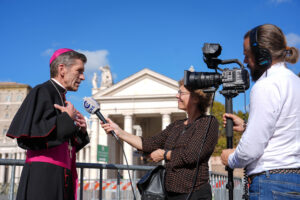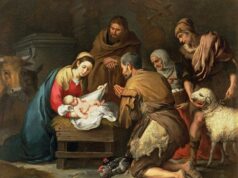Bishop William E. Koenig of the Diocese of Wilmington and two parishioners who were part of the pilgrimage the bishop led in Italy were interviewed by Catholic News Service Nov. 3 at St. Peter’s Square in Vatican City. Below is a transcript of those conversations.
CNS Rome:
You’re here at a time that the church is commemorating our faithful departed. What has it been like for you and the parishioners to have come to the grottoes, come to the basilica, the tomb of Saint Peter at this time? What significance does this have?
Bishop William E. Koenig:
Well, … yesterday, on All Souls Day, we went to the Church of St. Joseph’s for our Pilgrim Mass. And it was a moment, really, where it was a parish church, and St. Joseph, who we oftentimes pray to for a happy death, he is very much prominently displayed behind the altar there. So it was a very, just a very wonderful setting for us to gather and especially pray for our beloved who have passed before us.
And then today to come to St. Peter’s we had Mass this morning at the Tomb of St. Peter’s which is really, really a special, special experience and a special moment for ourselves as pilgrims in which we remember the foundation of our faith, that rock, St. Peter, who Jesus selected to be that founder of our church and, in his humaness, at times failed but, very much by the grace of God, became the first pope and certainly the rock on which our church is built.
CNS Rome:
Could you put it into context to help people understand the importance of commemorating the faithful departed, being here in Rome, and in the context of the Jubilee of Hope?
Bishop Koenig:
Sure, you know, we look to those people who have passed before us, and our Catholic faith really tells us that we’re on a pilgrimage to heaven and we leave this – our body, our spirit leaves our body and then we continue our pilgrimage to God.
And our doctrine that purgatory, which is often misunderstood …, a misunderstood dogma of our church, really says to us that we’re praying for that person who is going to get to heaven, but they still need some refinement.
And the way I think of it is, I’m from New York. And one of the big events there in November is the marathon. And I just know that from people who have run the marathon, that those people who are on the sidelines cheering the runners on make all the difference in the world. And so in many ways, I think our prayers for our beloved deceased who have left this world, that they continue on their transition to eternal life and to living in God’s presence forever, is cheering them on with our prayers.
CNS Rome:
In fact, Pope Francis once said he thought hell would be empty. Is that part of this idea of hope and faith?

Bishop Koenig:
Well again, our church teaches that hell does exist, our church doesn’t say who’s going to be in hell but just that we have to have that option of being able to choose heaven or hell. But I like Pope Francis’ thought that ultimately God’s mercy, especially as we look during this year of hope, is the one that’s going to welcome all of us to heaven.
CNS Rome:
Having come here with 115 parishioners, what it’s been like to come on a jubilee, and how you’ve been helping folks back home who perhaps couldn’t come to Rome, what does this mean for you?
Bishop Koenig:
I’m blessed to be here with those 115, and five of them are the priests from the diocese.
And it’s really a blessing for me to be able to celebrate Mass with the priests and with the parishioners of our diocese.
And on pilgrimage, it’s different than a vacation insofar as we’re not just seeing sites, we’re using this time for prayer. And so Mass has been an important part of every day, moments in which we can take time for quietness, whether it’s in a shrine to St. Pio, whether it’s in a shrine to St. Rita of Cascia, it is a moment that … deepens our faith. And then, you know, the important thing is that it’s not just meant to be a pilgrimage that goes for a week and a half or so, but we bring back what we’ve experienced and live as people of hope, as Pope Francis … called us to be, pilgrims of hope to others.
CNS Rome:
Any final words, anything you’d like to share?
Bishop Koenig:
Well, no, I thank you for your wonderful ministry here in the Eternal City and for allowing the people in the good old United States to get word of what’s happening here. So thank you. God bless.
— — —
CNS Rome:
The US bishops and the Catholic Church are seeking more ways to reach out to young people, and speaking as a younger person, why would a young person want to come here, why would you want to practice the faith?

Claire Trimble, 25, from the parish of Our Lady of Lourdes in Seaford, Delaware:
… Outreach is very important. Ever since (I was) a little kid, I love the community of being together with everyone, the fellowship. So, really having that one-on-one and greeting people, I believe, is what’s really gonna spark the young people and see that we are truly a part of the Catholic Church. We are the church of the living, and we are still a part of this church. It’s not you have to be a certain age or anything, you know, even babies are baptized and they are welcomed into the church.
So … from infants or young ones, including them and really taking them on different journeys, even from the home to their local parishes, getting them involved in catechesis so that we are able to have a good foundation is wonderful for us, it truly is. And I know that there are some households that are struggling and everything, but definitely like praying for them and helping them through all different journeys and everything, from at school, at work, or even in the grocery store, it’s very, very important that that little bit really truly touches our hearts.
CNS Rome:
A lot of emphasis is on outreach, on how best to meet young people. Would you say that is best done in person, face-to-face, or on online platforms?
Trimble:
I think online. I think my generation, (after) Gen X, is definitely switching now from more social media, as much as they are a great announcement, but truly, the heart is when we talk to each other. And especially since we’re the generation that, even the youngest generation, Gen Alpha, we went through schools, and it was very, very different from the typical way of in-person. And we really long for the in-person-ness of everything, and that oneness and that solidarity with each other.
And then really trying to talk with multiple generations. I personally love hearing, you know, just the differences between a 10-year gap or anything, like siblings, how siblings are very different from each other, when they’re like polar opposites. It’s very funny, like personality-wise, and I think that’s something that, you know, the church sees in the diversity of everyone.
CNS Rome:
What was your motivation to come here to Rome on pilgrimage?
Trimble:
Well, this is my first time out of the country, so that was a big one. I wanted to use my password for sure. But honestly, to spend time with our bishop. He shepherds us. He’s our leader for us and our diocese. And to really just hang out with him and the loveliness of all our priests and our two sisters that are with us. That was a nice surprise. And they’re very humble. They’re very down to earth. It’s wonderful to have dinner and lunch with them and just chat.
It’s so beautiful that we are able to experience that (with) someone who is ordained or consecrated life and religious. It’s so beautiful to just chat with them and just hang out with them. It really, truly is, that closeness and that in-person is so much different from just sending a text message or commenting on them online.
— — —
CNS Rome:
Tell us about your journey toward embracing the Catholic faith:

Keith Rudy from the parish of St. John the Beloved in Wilmington, Delaware:
Great story. So the first time I was in Rome was in January 1997, and my wife had highly suggested the trip. Sure, why not? I was not Catholic at the time, so we stopped in, and I had done some reading about St. Peter’s, and I read that St. Peter’s foot, the statue of St. Peter’s foot had been deformed over the years from the thousands and thousands of pilgrims. So I said hello to St. Peter and I touched his foot. About a year later, I got baptized as an adult. So I had my wife to thank for that.
And so our trip back has been quite a spiritual journey. A lot of sites, a lot of saints, and a lot of really interesting and holy experiences. So the country of Italy is fantastic. The people are fantastic. And this has just been a remarkable trip.
CNS Rome:
One of their church’s priorities is to reach out to folks like you who didn’t belong to any faith or have been disaffected from the Catholic faith. What is it that the church can do that attracted you, for example, what was it that touched you?
Rudy:
So throughout my whole life God was calling me, and I was preoccupied, or I don’t know if I was really open to listen, and I think it took St. Peter to help me make that connection.
I don’t know, there’s probably no one singular answer because everybody’s journey is different, and you know, there is some value in that journey. It can’t be prescribed. It can’t be directed, I think the Catholic Church just needs to be there. And when individuals finally understand and finally heed the call, I think they’ll turn to the church.
CNS Rome:
Any final comments, what it has been like to be here for the Jubilee, what that means?
Rudy:
It’s magnificent. It definitely renewed my faith and recharged me. And again, now having an understanding of everything that I saw almost 30 years ago, it has a different value.








